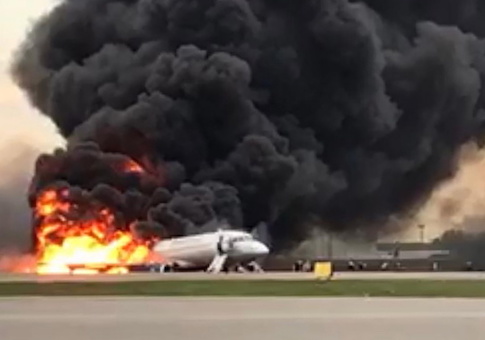KIEV, Ukraine—An Aeroflot-operated Sukhoi Superjet 100 regional passenger jet crashed and burned in a "hard landing" at Moscow's Sheremyetevo airport on Sunday, killing 41 of the 78 passengers on board.
Flight 1492 took off on schedule for a two-hour trip to the northern port city of Murmansk, but returned only a few minutes after take-off, having reported an in-flight technical failure. Original reports were of a lightning strike, but an on-board electrical short circuit is now being examined as the cause for the aircraft catching fire.
Aviation observers are not surprised by the crash.
The Superjet has a history of numerous safety problems that have caused emergency landings. One aircraft was completely lost and all on board killed in 2012 when it flew into the side of a mountain in Indonesia because the flight crew ignored the terrain avoidance warning system (TAWS). It has had little commercial appeal and its developmental cost ended up being almost four times the manufacturer's estimate.
Aeroflot, which is Russia's national carrier, and some other Russian airlines have been forced to take delivery of some Superjets because it is a domestic product, according to a Russian aviation specialist in Moscow.
In 2011, Russian journalist Ilya Varlamov recounted his experience with the aircraft. He described several flaws of the aircraft that were being covered up. Varlamov flew on the Superjet with Armavia airlines and claimed photographs on board were strictly prohibited and said the plane was falling apart despite having been in operation for less than a month.
Varlamov went on to describe hatches that didn't hold oxygen masks, overhead baggage compartments that spontaneously opened, and cheap thin film on the windows.
By 2012, Armavia had declared it no longer wished to take delivery of the second and third Superjet models it had on order and that it also wanted to transfer the aircraft that Varlamov had flown on the year before back to the manufacturer due to its unreliability.
In December 2010, the Italian national carrier Alitalia dropped a $500 million order of the Superjet after repeated delays. Alitalia purchased the popular regional E-jet models from Brazil's Embraer instead.
Other Superjet sales that were announced with great fanfare at various international air shows have failed to materialize.
So far only 300 of the aircraft have been ordered and slightly more than half that number produced.
Critics have pointed out that the Superjet was designed by Sukhoi, which has a long history of developing fighter aircraft but no experience designing commercial passenger aircraft, where cost savings are a far greater priority.
The Komsomolsk-na-Amure plant (KNAAPO) where the Superjet is built is known for high levels of sophistication and engineering skill in the production of Sukhoi fighter jets—including the Su-57 fifth-generation Russian fighter that is currently in flight test validation.
Many of the Superjet's on-board systems are foreign-made, making the purchase of spare parts for the aircraft complicated due to the many sanctions that have been levied against Russia for its invasion and illegal occupation of regions in Ukraine.
The aircraft has earned the enmity of most of the air crew personnel that work Superjet flights, a sign of an inferior design. Just after the 2012 crash in Indonesia, an Aeroflot flight attendant, Ekaterina Solovyeva, was fired from the airline after she tweeted, "Huh? Did a Superjet crash? Hahaha! This aircraft sucks, it's a pity it wasn't one [of those in service] with Aeroflot, then there would be one less."
